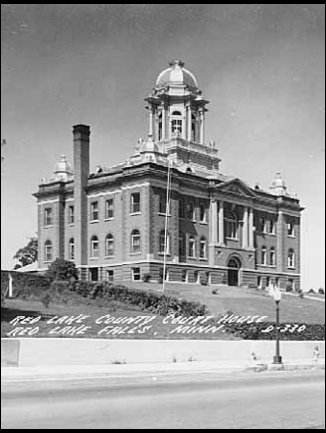 |
|
|
The Terrebonne Milling Company served the largest number of famers in Red Lake County from 1884 to the big fire on July 4, 1954, a period of 70 years.
|
|
It was in 1884 that Hanibal Ames built a roller mill on the Clearwater River just north of Terrebonne. The mill operated for three years until 1887 when it burned. Rebuilt the following year by Ames, it was later purchased by Henry Hennemuth and Richard Ohm who continued the operation until 1894 when Charles O. Kankel and Charles F. Kankel, cousins, purchased the Hennemuth interest. John Ziegler bought out the Ohm interest, later selling it to Charles Juhl who in turn sold to Charles O. Kankel. The mill was three stories high and had a basement 40 by 42 feet.. The machinery was of the latest pattern and the flour was of excellent quality. The dam was constructed of rock and crib work, about 175 feet in width, and furnished with a 12 foot head and a 56-inch turbine wheel. The mill at this time had the capacity of 100 barrels per day and was run to full capacity night and day. Following the destruction of this second mill by fire in January of 1915, Charles O. Kankel and Joseph W. Ste. Marie, partners, began building a third mill in May of the same year to become operational on Thanksgiving Day. Because money was needed to rebuild, Kankel and Ste. Marie sold shares of stock and changed the name from Terrebonne Roller Mill to the Terrebonne Milling Company. As the business prospered these shares were repurchased by the co-owners. The third and final mill was a very large structure three stories high with an attached warehouse. In later years the warehouse was enlarged and a garage added. The grain that was processed in this mill was crushed with huge rollers instead of a millstone. Once a year these rollers had to be hauled to the Twin Cities to be repaired. The mill operated year-round and up until 1931 depended solely upon water power. Water from the river was forced through a millrace by a dam on the river.. As the water passed through the millrace, it turned a giant waterwheel that turned the rollers. In 1911 the water level in the river became so low the mill was only able to operate part-time and it was then the partners decided to install a diesel engine. It was not until 1941 that the Red Lake Electric lines were installed. All hauling of grain and flour was done by wagons and teams of mules or horses until 1920 when a Reo truck was purchased. When flour was to be shipped, it was hauled by wagons or trucks to the nearest railway line, usually at Red Lake Falls or Mentor. |
The mill processed and shipped thousands of barrels of flour overseas during World War 11. It took about three bushels of wheat to make 100 pounds of flour. The best quality flour produced was the LaBelle brand, an enriched brand. The second quality was called Snoball. The mill also made bran, whole wheat flour and a cereal called Buddies Breakfast Food.
It is interesting to note that during the depression years the mill operated around the clock, even employing a night miller. Because of the economic situation, the farmers hauled their own grain from very long distances to be ground into flour for their own use or to be sold.
Competition from the large milling companies following World War 11 brought a decline in the need for the smaller local mills. Thus, when the spectacular and horrendous fire on the night of July 4, 1954, caused by a combustion that leveled the Terrebonne Mill, it signaled an end to a business made obsolete by time and progress.
(Information for the Terrebonne Mill was gathered by Tracy Kankel in 1976 when she did an interview with Mrs. Joseph Ste. Marie, a family friend who came to the mill site as a bride in 1914.)